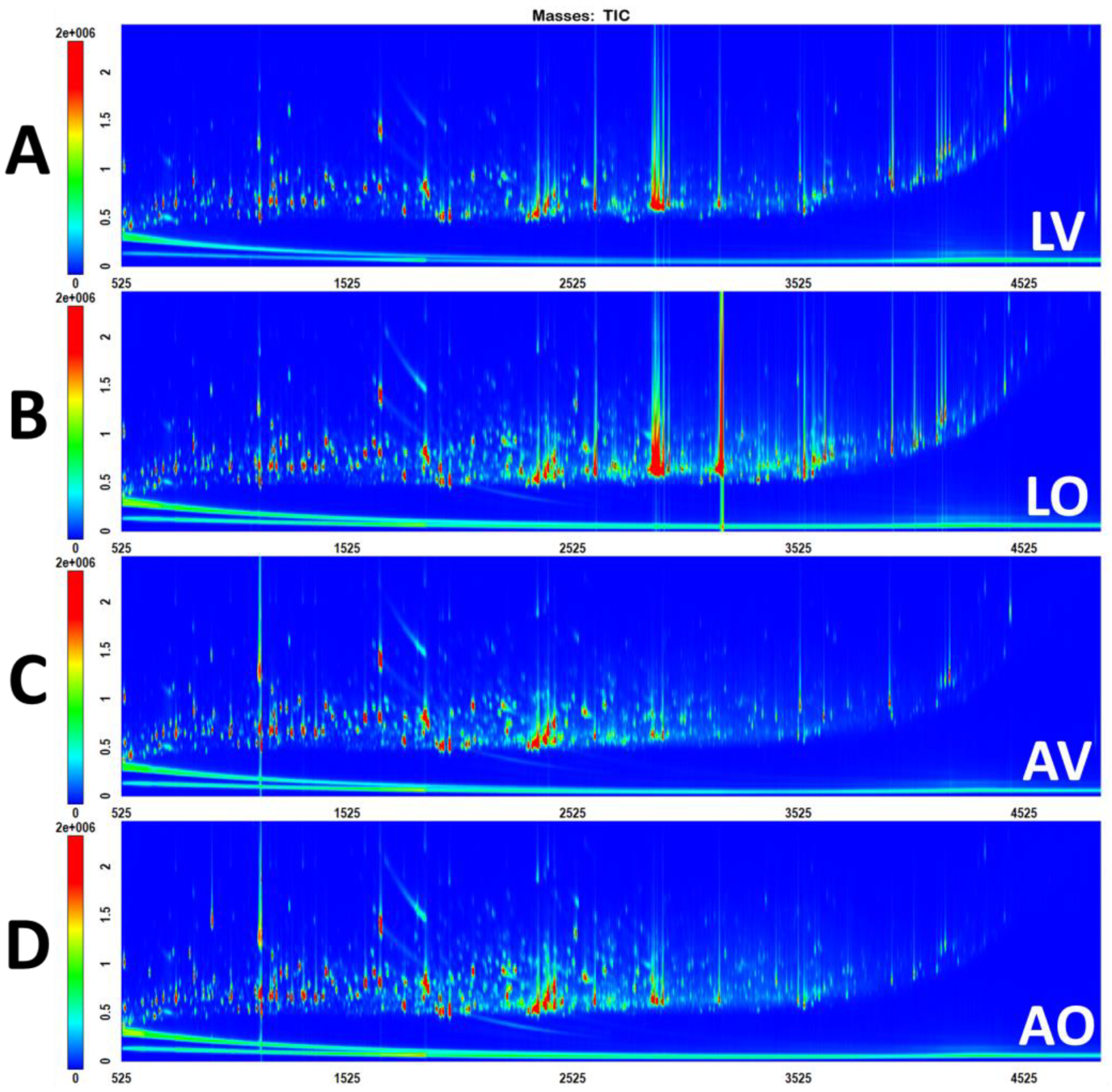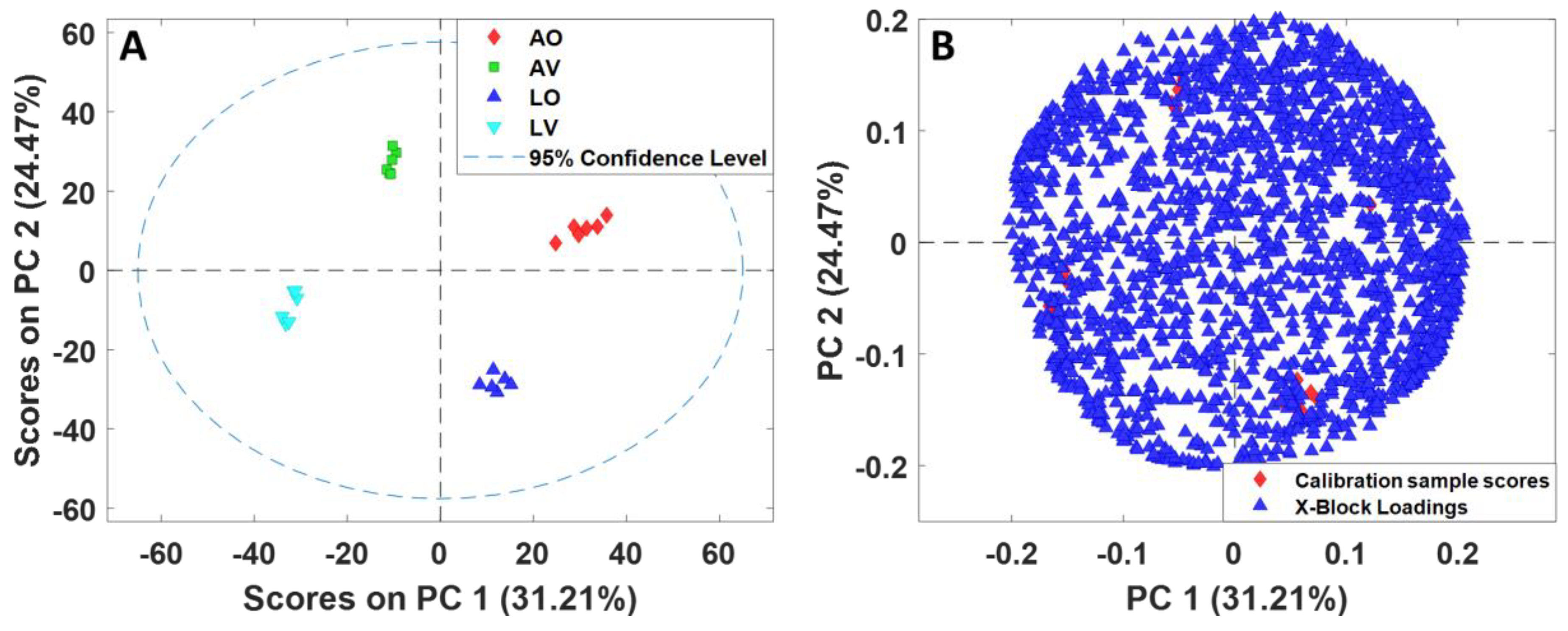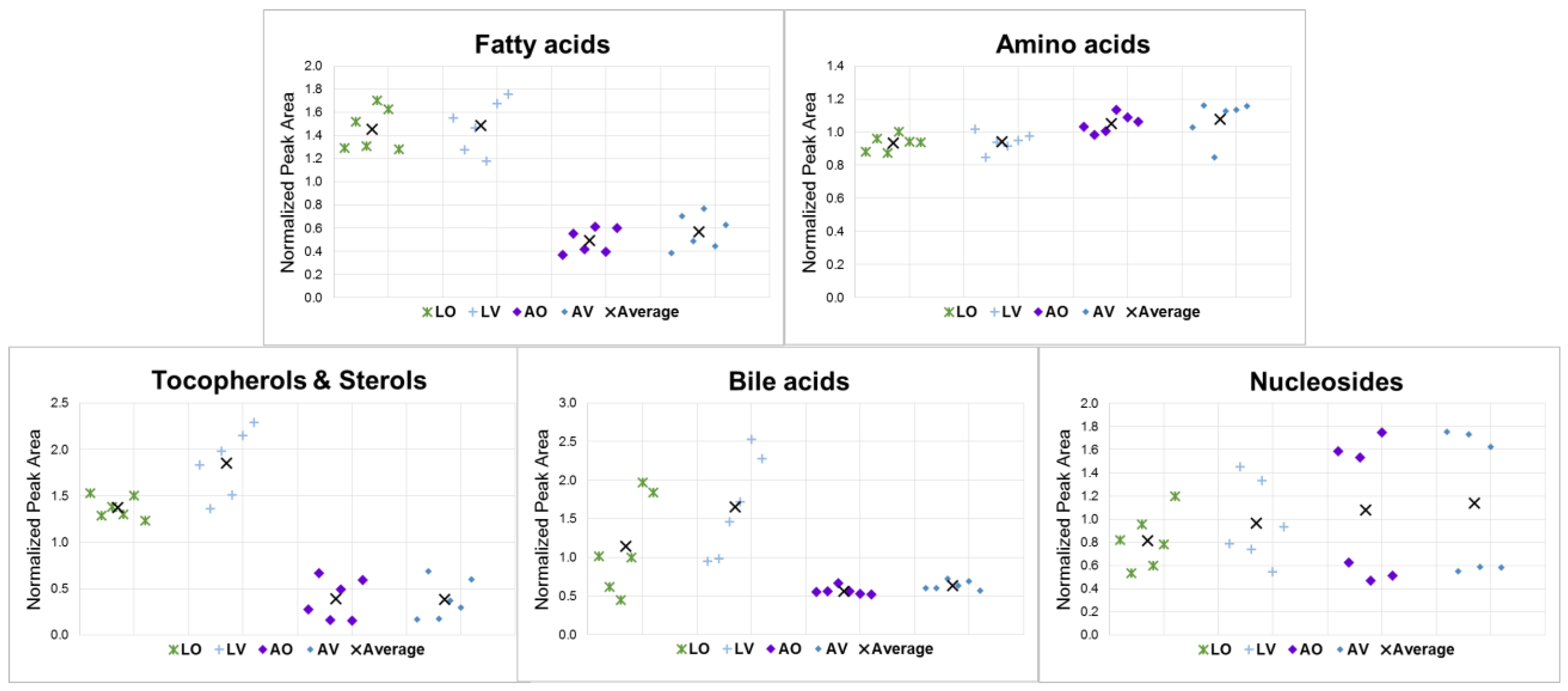Untargeted Metabolomic Profiling of Aqueous and Lyophilized Pooled Human Feces from Two Diet Cohorts Using Two-Dimensional Gas Chromatography Coupled with Time-of-Flight Mass Spectrometry
Abstract
:1. Introduction
2. Materials and Methods
2.1. Samples
2.2. Chemicals
2.3. Sample Preparation
2.4. GC×GC-TOFMS Conditions
2.5. Data Processing and Analysis
3. Results and Discussion
3.1. General Comparison
3.2. Most Abundant Metabolites
3.3. Chemometrics Analysis and Feature Selection
3.4. Analysis via Compound Classes
4. Conclusions
Supplementary Materials
Author Contributions
Funding
Institutional Review Board Statement
Informed Consent Statement
Data Availability Statement
Acknowledgments
Conflicts of Interest
References
- Almstetter, M.F.; Oefner, P.J.; Dettmer, K. Comprehensive Two-Dimensional Gas Chromatography in Metabolomics. Anal. Bioanal. Chem. 2012, 402, 1993–2013. [Google Scholar] [CrossRef]
- Sun, Y.V.; Hu, Y.-J. Chapter Three—Integrative Analysis of Multi-Omics Data for Discovery and Functional Studies of Complex Human Diseases. In Advances in Genetics; Friedmann, T., Dunlap, J.C., Goodwin, S.F., Eds.; Academic Press: Cambridge, MA, USA, 2016; Volume 93, pp. 147–190. ISBN 0065-2660. [Google Scholar]
- Bermingham, K.M.; Brennan, L.; Segurado, R.; Barron, R.E.; Gibney, E.R.; Ryan, M.F.; Gibney, M.J.; O’Sullivan, A.M. Genetic and Environmental Contributions to Variation in the Stable Urinary NMR Metabolome over Time: A Classic Twin Study. J. Proteome Res. 2021, 20, 3992–4000. [Google Scholar] [CrossRef] [PubMed]
- Chen, L.; Zhernakova, D.V.; Kurilshikov, A.; Andreu-Sánchez, S.; Wang, D.; Augustijn, H.E.; Vich Vila, A.; Weersma, R.K.; Medema, M.H.; Netea, M.G.; et al. Influence of the Microbiome, Diet and Genetics on Inter-Individual Variation in the Human Plasma Metabolome. Nat. Med. 2022, 28, 2333–2343. [Google Scholar] [CrossRef]
- Lee, I.-H.; Smith, M.R.; Yazdani, A.; Sandhu, S.; Walker, D.I.; Mandl, K.D.; Jones, D.P.; Kong, S.W. Comprehensive Characterization of Putative Genetic Influences on Plasma Metabolome in a Pediatric Cohort. Hum. Genom. 2022, 16, 67. [Google Scholar] [CrossRef]
- Holmes, E.; Li, J.V.; Athanasiou, T.; Ashrafian, H.; Nicholson, J.K. Understanding the Role of Gut Microbiome–Host Metabolic Signal Disruption in Health and Disease. Trends Microbiol. 2011, 19, 349–359. [Google Scholar] [CrossRef]
- Contrepois, K.; Liang, L.; Snyder, M. Can Metabolic Profiles Be Used as a Phenotypic Readout of the Genome to Enhance Precision Medicine? Clin. Chem. 2016, 62, 676–678. [Google Scholar] [CrossRef] [PubMed] [Green Version]
- Serkova, N.J.; Standiford, T.J.; Stringer, K.A. The Emerging Field of Quantitative Blood Metabolomics for Biomarker Discovery in Critical Illnesses. Am. J. Respir. Crit. Care Med. 2011, 184, 647–655. [Google Scholar] [CrossRef] [Green Version]
- Bang, G.; Park, J.H.; Park, C.; Kim, K.; Kim, J.K.; Lee, S.Y.; Kim, J.Y.; Park, Y.H. High-Resolution Metabolomics-Based Biomarker Discovery Using Exhaled Breath Condensate from Patients with Lung Cancer. J. Anal. Sci. Technol. 2022, 13, 37. [Google Scholar] [CrossRef]
- Brunmair, J.; Gotsmy, M.; Niederstaetter, L.; Neuditschko, B.; Bileck, A.; Slany, A.; Feuerstein, M.L.; Langbauer, C.; Janker, L.; Zanghellini, J.; et al. Finger Sweat Analysis Enables Short Interval Metabolic Biomonitoring in Humans. Nat. Commun. 2021, 12, 5993. [Google Scholar] [CrossRef]
- Langenau, J.; Oluwagbemigun, K.; Brachem, C.; Lieb, W.; Giuseppe, R.D.; Artati, A.; Kastenmüller, G.; Weinhold, L.; Schmid, M.; Nöthlings, U. Blood Metabolomic Profiling Confirms and Identifies Biomarkers of Food Intake. Metabolites 2020, 10, 468. [Google Scholar] [CrossRef]
- Zhao, R.; Ren, S.; Li, C.; Guo, K.; Lu, Z.; Tian, L.; He, J.; Zhang, K.; Cao, Y.; Liu, S.; et al. Biomarkers for Pancreatic Cancer Based on Tissue and Serum Metabolomics Analysis in a Multicenter Study. Cancer Med. 2022, 12, 5158–5171. [Google Scholar] [CrossRef]
- Wang, R.; Kang, H.; Zhang, X.; Nie, Q.; Wang, H.; Wang, C.; Zhou, S. Urinary Metabolomics for Discovering Metabolic Biomarkers of Bladder Cancer by UPLC-MS. BMC Cancer 2022, 22, 214. [Google Scholar] [CrossRef] [PubMed]
- Hyvärinen, E.; Savolainen, M.; Mikkonen, J.J.W.; Kullaa, A.M. Salivary Metabolomics for Diagnosis and Monitoring Diseases: Challenges and Possibilities. Metabolites 2021, 11, 587. [Google Scholar] [CrossRef] [PubMed]
- Gardner, A.; Carpenter, G.; So, P.-W. Salivary Metabolomics: From Diagnostic Biomarker Discovery to Investigating Biological Function. Metabolites 2020, 10, 47. [Google Scholar] [CrossRef] [Green Version]
- Zhgun, E.S.; Ilina, E.N. Fecal Metabolites As Non-Invasive Biomarkers of Gut Diseases. Acta Naturae 2020, 12, 4–14. [Google Scholar] [CrossRef] [PubMed]
- Jain, A.; Li, X.H.; Chen, W.N. An Untargeted Fecal and Urine Metabolomics Analysis of the Interplay between the Gut Microbiome, Diet and Human Metabolism in Indian and Chinese Adults. Sci. Rep. 2019, 9, 9191. [Google Scholar] [CrossRef] [Green Version]
- Chen, M.X.; Wang, S.-Y.; Kuo, C.-H.; Tsai, I.-L. Metabolome Analysis for Investigating Host-Gut Microbiota Interactions. J. Formos. Med. Assoc. 2019, 118, S10–S22. [Google Scholar] [CrossRef]
- Karu, N.; Deng, L.; Slae, M.; Guo, A.C.; Sajed, T.; Huynh, H.; Wine, E.; Wishart, D.S. A Review on Human Fecal Metabolomics: Methods, Applications and the Human Fecal Metabolome Database. Anal. Chim. Acta 2018, 1030, 1–24. [Google Scholar] [CrossRef]
- Gratton, J.; Phetcharaburanin, J.; Mullish, B.H.; Williams, H.R.T.; Thursz, M.; Nicholson, J.K.; Holmes, E.; Marchesi, J.R.; Li, J.V. Optimized Sample Handling Strategy for Metabolic Profiling of Human Feces. Anal. Chem. 2016, 88, 4661–4668. [Google Scholar] [CrossRef]
- Moosmang, S.; Pitscheider, M.; Sturm, S.; Seger, C.; Tilg, H.; Halabalaki, M.; Stuppner, H. Metabolomic Analysis—Addressing NMR and LC-MS Related Problems in Human Feces Sample Preparation. Clin. Chim. Acta 2019, 489, 169–176. [Google Scholar] [CrossRef]
- Ramamoorthy, S.; Levy, S.; Mohamed, M.; Abdelghani, A.; Evans, A.M.; Miller, L.A.D.; Mehta, L.; Moore, S.; Freinkman, E.; Hourigan, S.K. An Ambient-Temperature Storage and Stabilization Device Performs Comparably to Flash-Frozen Collection for Stool Metabolomics in Infants. BMC Microbiol. 2021, 21, 59. [Google Scholar] [CrossRef]
- Stevens, V.L.; Hoover, E.; Wang, Y.; Zanetti, K.A. Pre-Analytical Factors That Affect Metabolite Stability in Human Urine, Plasma, and Serum: A Review. Metabolites 2019, 9, 156. [Google Scholar] [CrossRef] [PubMed] [Green Version]
- Wang, Z.; Zolnik, C.P.; Qiu, Y.; Usyk, M.; Wang, T.; Strickler, H.D.; Isasi, C.R.; Kaplan, R.C.; Kurland, I.J.; Qi, Q.; et al. Comparison of Fecal Collection Methods for Microbiome and Metabolomics Studies. Front. Cell. Infect. Microbiol. 2018, 8, 301. [Google Scholar] [CrossRef] [Green Version]
- O’Sullivan, V.; Madrid-Gambin, F.; Alegra, T.; Gibbons, H.; Brennan, L. Impact of Sample Storage on the NMR Fecal Water Metabolome. ACS Omega 2018, 3, 16585–16590. [Google Scholar] [CrossRef] [Green Version]
- Nam, S.L.; Tarazona Carrillo, K.; de la Mata, A.P.; de Bruin, O.M.; Doukhanine, E.; Harynuk, J. Evaluation of Fresh, Frozen, and Lyophilized Fecal Samples by SPME and Derivatization Methods Using GC×GC-TOFMS. Metabolomics 2022, 18, 25. [Google Scholar] [CrossRef] [PubMed]
- Phua, L.C.; Koh, P.K.; Cheah, P.Y.; Ho, H.K.; Chan, E.C.Y. Global Gas Chromatography/Time-of-Flight Mass Spectrometry (GC/TOFMS)-Based Metabonomic Profiling of Lyophilized Human Feces. J. Chromatogr. B 2013, 937, 103–113. [Google Scholar] [CrossRef] [PubMed]
- Gao, X.; Pujos-Guillot, E.; Sébédio, J.-L. Development of a Quantitative Metabolomic Approach to Study Clinical Human Fecal Water Metabolome Based on Trimethylsilylation Derivatization and GC/MS Analysis. Anal. Chem. 2010, 82, 6447–6456. [Google Scholar] [CrossRef]
- Klinder, A.; Karlsson, P.C.; Clune, Y.; Hughes, R.; Glei, M.; Rafter, J.J.; Rowland, I.; Collins, J.K.; Pool-Zobel, B.L. Fecal Water as a Non-Invasive Biomarker in Nutritional Intervention: Comparison of Preparation Methods and Refinement of Different Endpoints. Nutr. Cancer 2007, 57, 158–167. [Google Scholar] [CrossRef] [PubMed]
- Gao, X.; Pujos-Guillot, E.; Martin, J.-F.; Galan, P.; Juste, C.; Jia, W.; Sebedio, J.-L. Metabolite Analysis of Human Fecal Water by Gas Chromatography/Mass Spectrometry with Ethyl Chloroformate Derivatization. Anal. Biochem. 2009, 393, 163–175. [Google Scholar] [CrossRef]
- Ganobis, C.M.; Al-Abdul-Wahid, M.S.; Renwick, S.; Yen, S.; Carriero, C.; Aucoin, M.G.; Allen-Vercoe, E. 1D 1H NMR as a Tool for Fecal Metabolomics. Curr. Protoc. Chem. Biol. 2020, 12, e83. [Google Scholar] [CrossRef]
- Xu, J.; Zhang, Q.-F.; Zheng, J.; Yuan, B.-F.; Feng, Y.-Q. Mass Spectrometry-Based Fecal Metabolome Analysis. TrAC Trends Anal. Chem. 2019, 112, 161–174. [Google Scholar] [CrossRef]
- Cui, M.; Trimigno, A.; Aru, V.; Khakimov, B.; Engelsen, S.B. Human Faecal 1H NMR Metabolomics: Evaluation of Solvent and Sample Processing on Coverage and Reproducibility of Signature Metabolites. Anal. Chem. 2020, 92, 9546–9555. [Google Scholar] [CrossRef]
- Wu, J.; Ye, Y.; Quan, J.; Ding, R.; Wang, X.; Zhuang, Z.; Zhou, S.; Geng, Q.; Xu, C.; Hong, L.; et al. Using Nontargeted LC-MS Metabolomics to Identify the Association of Biomarkers in Pig Feces with Feed Efficiency. Porc. Health Manag. 2021, 7, 39. [Google Scholar] [CrossRef] [PubMed]
- Nam, S.L.; de la Mata, A.P.; Dias, R.P.; Harynuk, J.J. Towards Standardization of Data Normalization Strategies to Improve Urinary Metabolomics Studies by GC×GC-TOFMS. Metabolites 2020, 10, 376. [Google Scholar] [CrossRef] [PubMed]
- Nam, S.L.; de la Mata, A.P.; Harynuk, J.J. Automated Screening and Filtering Scripts for GC×GC-TOFMS Metabolomics Data. Separations 2021, 8, 84. [Google Scholar] [CrossRef]
- Higgins Keppler, E.A.; Jenkins, C.L.; Davis, T.J.; Bean, H.D. Advances in the Application of Comprehensive Two-Dimensional Gas Chromatography in Metabolomics. TrAC Trends Anal. Chem. 2018, 109, 275–286. [Google Scholar] [CrossRef]




| Vegans | Omnivores | ||||||
|---|---|---|---|---|---|---|---|
| Number of Peaks | Average | RSD (%) | Number of Peaks | Average | RSD (%) | ||
| Lyophilized | TPA | 1417 | 1.93 × 109 | 15.2 | 1544 | 2.44 × 109 | 5.52 |
| TUPA | 1189 | 1.78 × 109 | 15.8 | 1279 | 2.28 × 109 | 6.27 | |
| Aqueous | TPA | 1506 | 2.46 × 109 | 1.64 | 1595 | 2.73 × 109 | 3.38 |
| TUPA | 1236 | 2.14 × 109 | 1.94 | 1306 | 2.40 × 109 | 3.97 | |
| Vegans | Omnivores | |||
|---|---|---|---|---|
| Compound | Rel. ab (%) | Compound | Rel. ab (%) | |
| Lyophlized | L-5-Oxoproline | 5.60 | L-5-Oxoproline | 5.96 |
| d-Ribose | 3.46 | 7H-purine | 3.86 | |
| Phenylalanine | 2.43 | Pyroglutamic acid | 3.46 | |
| Pyroglutamic acid | 2.32 | d-Ribose | 2.68 | |
| L-Threonine | 2.24 | D-Arabinose | 2.23 | |
| L-Aspartic acid | 1.93 | Phenylalanine | 1.87 | |
| Analyte 52 | 1.86 | L-Proline | 1.54 | |
| L-Leucine | 1.66 | L-Tyrosine | 1.44 | |
| Propylene glycol | 1.54 | 2-Monolinolenin | 1.39 | |
| D-(−)-Rhamnose | 1.40 | N-Methyl-à-aminoisobutyric acid | 1.30 | |
| 9,12-Octadecadienoic acid | 1.40 | 5-Hydroxyindoleacetic acid | 1.28 | |
| DL-Arabinose | 1.40 | L-Valine | 1.07 | |
| L-Tyrosine | 1.18 | Tricarballylic acid | 1.02 | |
| Glycine | 1.17 | |||
| Butanedioic acid | 1.10 | |||
| D-(+)-Xylose | 1.09 | |||
| Uric acid | 1.05 | |||
| d-Glucose | 1.07 | |||
| Total | 33.90 | Total | 29.09 | |
| Aqueous | L-5-Oxoproline | 5.79 | L-5-Oxoproline | 5.55 |
| 7H-purine | 3.91 | Pyroglutamic acid | 3.28 | |
| Pyroglutamic acid | 3.31 | 7H-purine | 3.05 | |
| Serine | 2.51 | Phenylalanine | 2.52 | |
| L-Alanine | 2.49 | Malic acid | 2.31 | |
| d-Ribose | 2.21 | L-Alanine | 2.06 | |
| Glycine | 1.84 | L-Tyrosine | 1.81 | |
| L-Tyrosine | 1.82 | d-Ribose | 1.64 | |
| L-Leucine | 1.67 | Glycine | 1.55 | |
| D-(−)-Rhamnose | 1.54 | L-Proline | 1.38 | |
| Uric acid | 1.50 | D-(+)-Cellobiose | 1.36 | |
| Analyte 48 | 1.35 | L-Isoleucine | 1.25 | |
| Propylene glycol | 1.34 | N-Methyl-à-aminoisobutyric acid | 1.22 | |
| L-(−)-Fucose | 1.31 | Analyte 50 | 1.19 | |
| L-Valine | 1.30 | L-Valine | 1.17 | |
| D-(+)-Xylose | 1.11 | Galactaric acid | 1.01 | |
| Monomethylphosphate | 1.00 | |||
| D-(+)-Xylose | 1.00 | |||
| Total | 34.99 | Total | 34.36 | |
Disclaimer/Publisher’s Note: The statements, opinions and data contained in all publications are solely those of the individual author(s) and contributor(s) and not of MDPI and/or the editor(s). MDPI and/or the editor(s) disclaim responsibility for any injury to people or property resulting from any ideas, methods, instructions or products referred to in the content. |
© 2023 by the authors. Licensee MDPI, Basel, Switzerland. This article is an open access article distributed under the terms and conditions of the Creative Commons Attribution (CC BY) license (https://creativecommons.org/licenses/by/4.0/).
Share and Cite
Nam, S.L.; Tarazona Carrillo, K.; de la Mata, A.P.; Harynuk, J.J. Untargeted Metabolomic Profiling of Aqueous and Lyophilized Pooled Human Feces from Two Diet Cohorts Using Two-Dimensional Gas Chromatography Coupled with Time-of-Flight Mass Spectrometry. Metabolites 2023, 13, 828. https://doi.org/10.3390/metabo13070828
Nam SL, Tarazona Carrillo K, de la Mata AP, Harynuk JJ. Untargeted Metabolomic Profiling of Aqueous and Lyophilized Pooled Human Feces from Two Diet Cohorts Using Two-Dimensional Gas Chromatography Coupled with Time-of-Flight Mass Spectrometry. Metabolites. 2023; 13(7):828. https://doi.org/10.3390/metabo13070828
Chicago/Turabian StyleNam, Seo Lin, Kieran Tarazona Carrillo, A. Paulina de la Mata, and James J. Harynuk. 2023. "Untargeted Metabolomic Profiling of Aqueous and Lyophilized Pooled Human Feces from Two Diet Cohorts Using Two-Dimensional Gas Chromatography Coupled with Time-of-Flight Mass Spectrometry" Metabolites 13, no. 7: 828. https://doi.org/10.3390/metabo13070828











